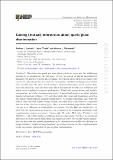| dc.contributor.author | Thaler, Jesse | |
| dc.contributor.author | Waalewijn, Wouter J. | |
| dc.contributor.author | Larkoski, Andrew | |
| dc.date.accessioned | 2015-02-18T17:59:57Z | |
| dc.date.available | 2015-02-18T17:59:57Z | |
| dc.date.issued | 2014-11 | |
| dc.date.submitted | 2014-10 | |
| dc.identifier.issn | 1029-8479 | |
| dc.identifier.issn | 1126-6708 | |
| dc.identifier.uri | http://hdl.handle.net/1721.1/94599 | |
| dc.description.abstract | Discriminating quark jets from gluon jets is an important but challenging problem in jet substructure. In this paper, we use the concept of mutual information to illuminate the physics of quark/gluon tagging. Ideal quark/gluon separation requires only one bit of truth information, so even if two discriminant variables are largely uncorrelated, they can still share the same “truth overlap”. Mutual information can be used to diagnose such situations, and thus determine which discriminant variables are redundant and which can be combined to improve performance. Using both parton showers and analytic resummation, we study a two-parameter family of generalized angularities, which includes familiar infrared and collinear (IRC) safe observables like thrust and broadening, as well as IRC unsafe variants like p [D over T] and hadron multiplicity. At leading-logarithmic (LL) order, the bulk of these variables exhibit Casimir scaling, such that their truth overlap is a universal function of the color factor ratio C [subscript A] [over C subscript F] . Only at next-to-leading-logarithmic (NLL) order can one see a difference in quark/gluon performance. For the IRC safe angularities, we show that the quark/gluon performance can be improved by combining angularities with complementary angular exponents. Interestingly, LL order, NLL order, Pythia 8, and Herwig++ all exhibit similar correlations between observables, but there are significant differences in the predicted quark/gluon discrimination power. For the IRC unsafe angularities, we show that the mutual information can be calculated analytically with the help of a nonperturbative “weighted-energy function”, providing evidence for the complementarity of safe and unsafe observables for quark/gluon discrimination. | en_US |
| dc.description.sponsorship | United States. Dept. of Energy (Cooperative Research Agreement DE-FG02-05ER-41360) | en_US |
| dc.description.sponsorship | Alfred P. Sloan Foundation (Sloan Research Fellowship) | en_US |
| dc.description.sponsorship | United States. Dept. of Energy. Office of Science (Early Career Research Program DE-FG02-11ER-41741) | en_US |
| dc.language.iso | en_US | |
| dc.publisher | Springer-Verlag | en_US |
| dc.relation.isversionof | http://dx.doi.org/10.1007/jhep11(2014)129 | en_US |
| dc.rights | Creative Commons Attribution | en_US |
| dc.rights.uri | http://creativecommons.org/licenses/by/4.0/ | en_US |
| dc.source | Springer-Verlag | en_US |
| dc.title | Gaining (mutual) information about quark/gluon discrimination | en_US |
| dc.type | Article | en_US |
| dc.identifier.citation | Larkoski, Andrew J., Jesse Thaler, and Wouter J. Waalewijn. “Gaining (mutual) Information About Quark/gluon Discrimination.” J. High Energ. Phys. 2014, no. 11 (November 2014). | en_US |
| dc.contributor.department | Massachusetts Institute of Technology. Center for Theoretical Physics | en_US |
| dc.contributor.department | Massachusetts Institute of Technology. Laboratory for Nuclear Science | en_US |
| dc.contributor.mitauthor | Larkoski, Andrew | en_US |
| dc.contributor.mitauthor | Thaler, Jesse | en_US |
| dc.relation.journal | Journal of High Energy Physics | en_US |
| dc.eprint.version | Final published version | en_US |
| dc.type.uri | http://purl.org/eprint/type/JournalArticle | en_US |
| eprint.status | http://purl.org/eprint/status/PeerReviewed | en_US |
| dspace.orderedauthors | Larkoski, Andrew J.; Thaler, Jesse; Waalewijn, Wouter J. | en_US |
| dc.identifier.orcid | https://orcid.org/0000-0002-3181-4301 | |
| dc.identifier.orcid | https://orcid.org/0000-0002-2406-8160 | |
| dspace.mitauthor.error | true | |
| mit.license | PUBLISHER_CC | en_US |
| mit.metadata.status | Complete | |
